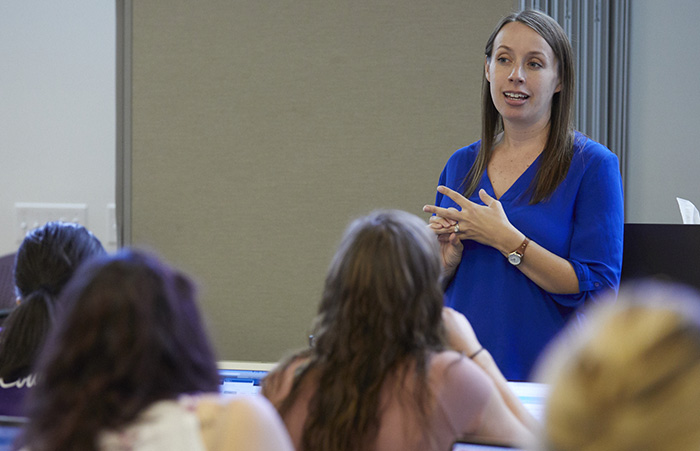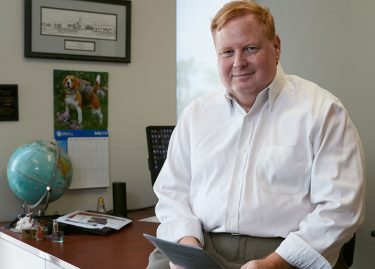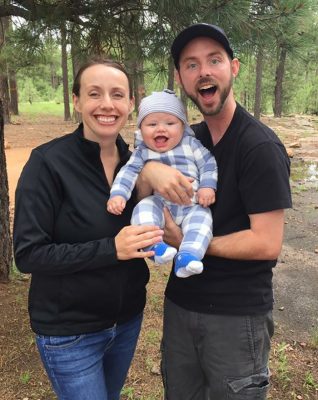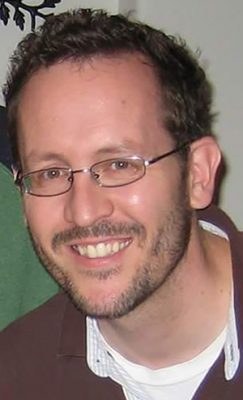
By Theresa Smith
GCU News Bureau
Babies often arrive on their own timetable, which was the case for Baby Jeffrey in 2017. Two weeks into his mother’s master’s math class, he came into the world, which meant that his library was filled with “God Created the Integers’’ and Nonlinear Dynamics and Chaos’’ along with “Maybe My Baby’’ and “Goodnight Moon.’’ While Jeffrey slept or nursed, his mother, Molly Elmer, was quick to prop open her math book for quiet reading sessions in her master's program.
Elmer embodies the dramatic impact of five new master’s degrees in teaching content programs at Grand Canyon University – programs that were launched to meet a need created by the Higher Learning Commission’s adoption of increased standards for faculty, effective Sept. 1, 2017. The HLC is an accreditation body for colleges and universities in a 19-state region of the United States, including Arizona.
Dr. Sherman Elliott, dean of the College of Humanities and Social Sciences, responded quickly when the HLC announced new standards in 2015, designing master’s programs for teaching specific content: English, communication, history, sociology and mathematics. With the exception of mathematics, all of them are available online, which makes them convenient for working teachers.
“These teachers don’t have time and money to go back to school at one o’clock in the middle of the day for graduate seminars,’’ said Elliott, who has taught at the high school, community college and university level.

Owing to its hands-on nature, mathematics is taught face-to-face on campus but is offered at night in four-hour sessions to accommodate the working schedules of dual-enrollment high school teachers, community college teachers and lower division university teachers seeking to keep their jobs by meeting the new requirements of the HLC.
Teachers who already have a master’s degree must gain 18 credit hours of graduate school credit in their teaching subject. For those without a master’s degree, 34 credit hours are required in the direct field they plan to teach -- for example, “mathematics,’’ not “mathematics education."
Currently, there are 114 students in the English program, 110 in communications, 89 in history, 67 in sociology and 35 in mathematics.
“It is one of our fastest-growing programs,’’ Elliott said. “I have been so grateful because it tells me we did rush to the market but we met a need. It is a big help because it allows people to keep their jobs. And I am not just talking about Arizona; they can be in New Mexico, Colorado, anyone dealing with HLC accreditation.’’
In an example of cross-college collaboration, two of the required classes are taught in the College of Education -- EDU 534: Effective Pedagogy for Higher Education and EDU 548: Curricular and Instructional Methods in Higher Education. For Elmer, the only other non-math class was the first of the program, a two-credit course, UNV (meaning University) 503: Introduction to Graduate Studies in the Liberal Arts.
Balancing family and a teaching career
The multitasking Elmer is unique among the first graduates of the program, given her distinction as the first to be hired as a full-time lecturer by GCU. She teaches two sections of college mathematics, two sections of applications of college algebra and one Calculus I class.
Before the program launched, Elmer already was taking graduate school math classes at GCU. With the encouragement of faculty members, she continued on to meet HLC requirements. A few days after completing her degree, formally known as a Master of Science in Mathematics with an Emphasis in Education, she applied for a full-time faculty position at GCU.
“So many of us were so grateful when they put it into a program to gain an official degree,’’ she said.
It was a circuitous path for the cheerful and patient instructor, considering her bachelor’s degree and her first master’s degree were in anthropology. A Missouri native, she attended the University of Arizona for her undergraduate degree and Stony Brook in New York for her first master’s degree.

“My mom was a college math professor, so it was always something I was pretty good at it through high school and college, but I never considered it as something I wanted to do,’’ she said. “I love anthropology but there are not a lot of job opportunities teaching it, so when I finished grad school the jobs that were open led me into the math field, and I realized I did love it. My passion for it grew by working in the field."
In 2012, Elmer came to the GCU campus as a part-time instructional assistant in mathematics. While working full-time as an IA in 2015, she gave birth to Jeffrey and stayed home from teaching for several months, but she also worked on the master’s in math.
“My husband was a big help,’’ Elmer said of Tyler. “The great part about those classes being in the evening was that when my husband came home from work, he could watch our son and I could go to campus. I have had the traditional master’s program previously, and it is full time. By taking a part-time class load, I could balance my son and the program. While my son was taking naps, I did homework or I did homework at night after he went to bed. It was a balancing act, but the way the program was structured made it doable as a working adult.’’
Each class was taught on campus on a weeknight for four hours. In between, she studied on her own and met with her cohort, which was comprised of high school teachers looking to maintain or obtain the requirements to teach dual enrollment or adjunct college professors meeting the new requirements to keep their jobs.
“The great part for me about being in in-person cohort classes is that you are moving through them with the same group of people, so you form study groups,’’ Elmer said. “We met nearly every Saturday for two to three hours just to help each other and teach each other. It was a real gift, especially if you are stuck (on a problem). Talking it through with someone makes all the difference.’’
Elmer applies the same principles with her students now by conducting her office hours in the Math Center, located in Room 202 of the CHSS building.
“At the Math Center there is no pressure,’’ she said. “They can work with their headphones on and then ask a question when they have a question. They can do it on their own pace and not a one-on-one where they might feel uncomfortable. Since it is always staffed with math faculty, there is always someone there that can help them.’’
In an ironic sense, CHSS developed the program to help Elmer. In turn, she is helping scores of GCU students learn college math.
“We are affirming the person. It is a win-win,’’ Elliott said.
English masters emphasizes writing
While Elmer is explaining concepts and evaluating her student’s practice problem progress, Dr. Thomas Skeen is down the hall in his office preparing to teach a grant writing class.
Skeen, a GCU instructor for eight years, guides students through the process: finding a grant, matching needs, writing to the initial contact, crafting a proposal and preparing a budget.

Skeen also teaches writing theory (applied rhetoric/persuasion and communication), multimedia writing (creating a social media campaign), organizational communications, and writing in social and technological contexts. All the classes require the teacher-students to prepare lesson plans.
“We study how to get the content students learn to transfer from one context to another,’’ Skeen said. “The program is designed to model the things they can do in the classroom. They take a lot of writing classes. It is important to learn how to teach a lot of different kinds of writing."
Caitlin Velasco earned her bachelor’s degree from the College of Education and teaches eighth-grade language arts at a middle school in Tucson. In April, she enrolled in the master’s program and has flourished in two classes with Skeen: writing theory and social and technological contexts of writing.
“Dr. Skeen is amazing,’’ she said. “I have been an online learner for quite a few years because I do have a job and I do have three young children at home. I don’t think that not speaking in person has been a detriment in any way. Dr. Skeen was very responsive; he was always just a phone call away. ‘’
The mother of three, ages 10, 9 and 8, enrolled in the program to accelerate her career.
“I am looking for the flexibility to move up and teach dual enrollment at the high school level or eventually move forward in getting my Ph.D. to teach at the university level,’’ she said. “The GCU master’s program has been a fabulous experience. Since I am currently teaching, I am able to take the information I am learning as a student and the next day or the next week apply it in my own classroom with my own students – translating those ideas, obviously on a lower level of rigor.‘’
Among those mirrored assignments, the energetic Velasco teaches email writing, social media use and how to write letters of recommendation.
“We do struggle with writing at the middle school level,’’ she said. “They don’t get it and they don’t see the point in it. So I am taking some of the learning theories and application processes from GCU and I am just changing the way I have been teaching writing to make it more realistic. It is interesting to see how students change and respond more positively.’’
Skeen could say the same thing about Velasco: His teaching of the teacher is not just paying off down the road in 2021, it is paying off right now, down the road in a middle school class in Tucson -- just as Elmer’s mastery of the CHSS master's program is impacting her GCU students today.
Contact Theresa Smith at (602) 639-7457 or [email protected].
***
Related content:
Higher Learning Commission: Determining qualified faculty
Inside Higher Ed: Scramble for Dual-Credit Certification




